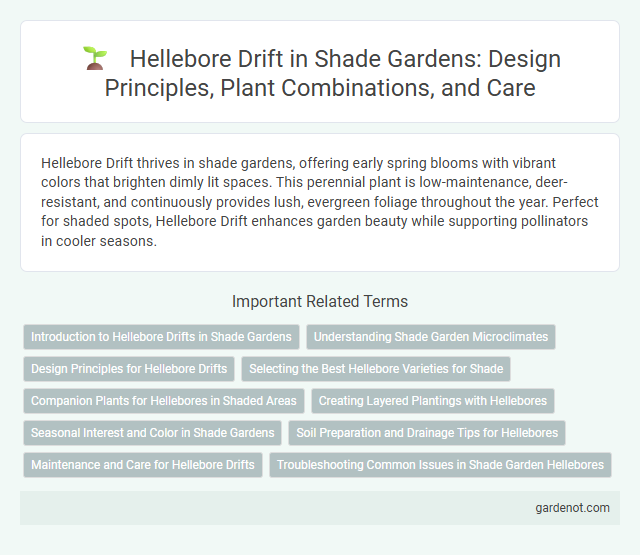Hellebore Drift thrives in shade gardens, offering early spring blooms with vibrant colors that brighten dimly lit spaces. This perennial plant is low-maintenance, deer-resistant, and continuously provides lush, evergreen foliage throughout the year. Perfect for shaded spots, Hellebore Drift enhances garden beauty while supporting pollinators in cooler seasons.
Introduction to Hellebore Drifts in Shade Gardens
Hellebore Drifts are ideal for shade gardens, thriving in low-light environments with rich, well-drained soil. These perennial plants bloom in late winter to early spring, offering an early burst of color with their nodding, cup-shaped flowers in shades of white, pink, purple, and green. Their evergreen foliage provides year-round interest, making Hellebore Drifts a valuable addition to shaded garden beds and woodland settings.
Understanding Shade Garden Microclimates
Hellebore Drift thrives in shade garden microclimates characterized by dappled sunlight and consistently moist, well-drained soil rich in organic matter. These perennials prefer cool, sheltered spots protected from harsh afternoon sun and strong winds, making them ideal for planting under deciduous trees or beside shaded garden structures. Monitoring soil temperature and humidity levels helps optimize growth, ensuring vibrant blooms and healthy foliage within diverse shade environments.
Design Principles for Hellebore Drifts
Hellebore drifts utilize repetition and mass planting to create visual impact and seasonal interest in shaded garden areas. Strategic layering with complementary textures and colors enhances depth while ensuring consistent bloom from late winter to early spring. Integrating Hellebore varieties with evergreen groundcovers maintains aesthetic appeal and supports sustainable shade garden design.
Selecting the Best Hellebore Varieties for Shade
Hellebore drift varieties such as Helleborus orientalis and Helleborus niger thrive in shaded garden areas, offering evergreen foliage paired with early spring blooms in shades of white, pink, and deep purple. Selecting cultivars like 'Anna's Red' and 'Pink Frost' ensures adaptability to low light conditions and resistance to common diseases, enhancing garden longevity. Prioritize well-drained, humus-rich soil and consistent moisture to optimize growth and vibrant flowering in shaded environments.
Companion Plants for Hellebores in Shaded Areas
Hellebore drift thrives alongside ferns, hostas, and astilbes in shaded garden areas, creating a harmonious blend of textures and foliage. These companion plants share similar moisture and soil preferences, enhancing the overall health and aesthetic appeal of the shade garden. Incorporating evergreen groundcovers like pachysandra or ivy further complements Hellebore drift by filling gaps and suppressing weeds.
Creating Layered Plantings with Hellebores
Hellebore Drift varieties offer a unique advantage for creating layered plantings in shade gardens due to their low-growing, clumping habit and evergreen foliage. These plants thrive in partial to full shade and bloom in late winter to early spring, providing early-season interest beneath taller shade plants like ferns or hostas. Combining Hellebore Drift with shade-tolerant perennials and groundcovers enhances textural contrast and extends seasonal visual appeal in woodland garden designs.
Seasonal Interest and Color in Shade Gardens
Hellebore drift offers exceptional seasonal interest in shade gardens with its early spring blooms that feature a palette of soft pinks, whites, and purples, providing vibrant color when few other plants flower. Its evergreen foliage maintains garden texture and lushness throughout winter, enhancing year-round appeal in shaded areas. The plant's durability and subtle, nodding flowers make it a standout choice for gardeners seeking low-maintenance, colorful ground cover in low-light environments.
Soil Preparation and Drainage Tips for Hellebores
Hellebore Drift thrives in well-drained, humus-rich soil with a slightly alkaline to neutral pH, making soil preparation critical for healthy growth. Incorporate organic matter such as compost or aged leaf mold to enhance soil structure and moisture retention while preventing waterlogging. Ensure proper drainage by planting hellebores in raised beds or amending heavy clay soils with coarse sand or grit to avoid root rot and encourage vigorous blooming.
Maintenance and Care for Hellebore Drifts
Hellebore Drifts require minimal maintenance, thriving in shaded or partially shaded garden areas with well-drained, humus-rich soil to prevent root rot. Regular removal of old, damaged leaves in late winter promotes healthy growth and reduces fungal diseases. Mulching with organic matter maintains soil moisture and temperature, supporting year-round vigor and bloom persistence.
Troubleshooting Common Issues in Shade Garden Hellebores
Hellebore Drift plants in shade gardens may encounter common issues such as leaf spot caused by fungal infections, which can be mitigated by improving air circulation and removing affected foliage. Slugs and snails frequently damage Hellebore Drift, so using organic slug pellets or barriers helps protect the plants. Ensuring proper soil drainage and avoiding overwatering prevents root rot, promoting vigorous growth in shaded environments.
Hellebore drift Infographic

 gardenot.com
gardenot.com